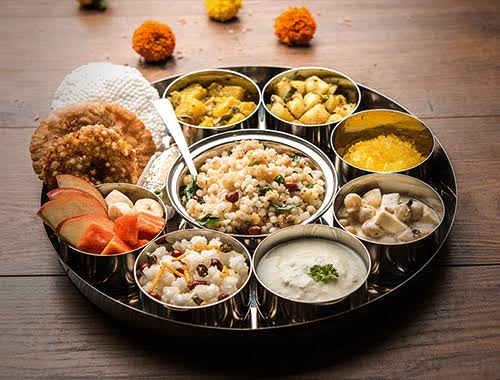Fasting is an integral part of Hindu culture, observed during festivals like Navratri, Ekadashi, Shivratri, and other religious occasions. While fasting, devotees abstain from regular food and consume specific vrat (fasting) foods that are considered pure and light.

If you’re observing a Hindu fast, knowing what to eat can help maintain energy levels while adhering to religious customs. This guide provides unique food options and answers common questions about fasting.
Best Foods to Eat During Hindu Fasting
1. Fruits & Nuts
- Bananas, apples, pomegranates, and berries
- Dry fruits like almonds, walnuts, and raisins
- Coconut (fresh or dried)
✅ Why? Fruits provide natural sugars for energy, while nuts offer healthy fats and protein.
2. Vrat-Friendly Grains & Flours
- Samak Rice (Barnyard Millet) – A popular fasting grain
- Singhare ka Atta (Water Chestnut Flour) – Used for making rotis or pancakes
- Kuttu ka Atta (Buckwheat Flour) – Great for making puris or parathas
- Rajgira (Amaranth) – Used in porridge or laddus
✅ Why? These grains are light, gluten-free, and considered pure for fasting.
3. Dairy Products
- Milk, yogurt, and buttermilk
- Paneer (cottage cheese) – Can be used in sabzi or sweets
- Ghee – Used in small quantities for cooking
✅ Why? Dairy is sattvic (pure) and provides calcium and protein.
4. Root Vegetables (Allowed in Some Fasts)
- Potatoes, sweet potatoes, yam, and colocasia (arbi)
- Pumpkin and bottle gourd
⚠️ Note: Some fasts (like Ekadashi) avoid all grains and even certain vegetables, so check fasting rules.
5. Light Meals & Snacks
- Sabudana Khichdi – Tapioca pearls cooked with peanuts and potatoes
- Makhana (Fox Nuts) Roasted – A crunchy, healthy snack
- Fruit Chaat – Mixed fruits with rock salt and lemon
- Lauki (Bottle Gourd) Juice – Hydrating and light
✅ Why? These foods are easy to digest and keep you full.
Foods to Avoid During Hindu Fasting
❌ Regular grains like wheat, rice, and lentils (in strict fasts)
❌ Onion and garlic (considered tamasic)
❌ Non-vegetarian food and alcohol
❌ Processed and fried foods (in excess)
FAQs on Hindu Fasting
1. Can I drink coffee or tea during fasting?
✔️ Yes, but without regular milk (use almond milk or have black tea). Some strict fasts avoid caffeine.
2. Are spices allowed in fasting food?
✔️ Yes, but avoid onion and garlic. Use rock salt (sendha namak), cumin, black pepper, and green chilies.
3. Can I eat fried foods like sabudana vada or kuttu puri?
✔️ Yes, but in moderation. Too much fried food can cause indigestion.
4. Is sugar allowed during fasting?
✔️ Yes, but some people prefer natural sweeteners like jaggery or honey.
5. Can I eat packaged “vrat” snacks?
✔️ Check ingredients—some contain forbidden flours or additives. Homemade is best.
6. What if I feel weak during fasting?
✔️ Drink coconut water, eat bananas, or have a handful of nuts for instant energy.
7. Can pregnant women or diabetics fast?
✔️ Consult a doctor first. They can modify the fast with fruits, nuts, and light meals.
Conclusion
Hindu fasting is not just about abstaining from food but eating mindfully. Choose sattvic, light, and nutritious options to stay energized while respecting religious customs.
Would you like a sample one-day fasting meal plan? Let us know in the comments! 🙏